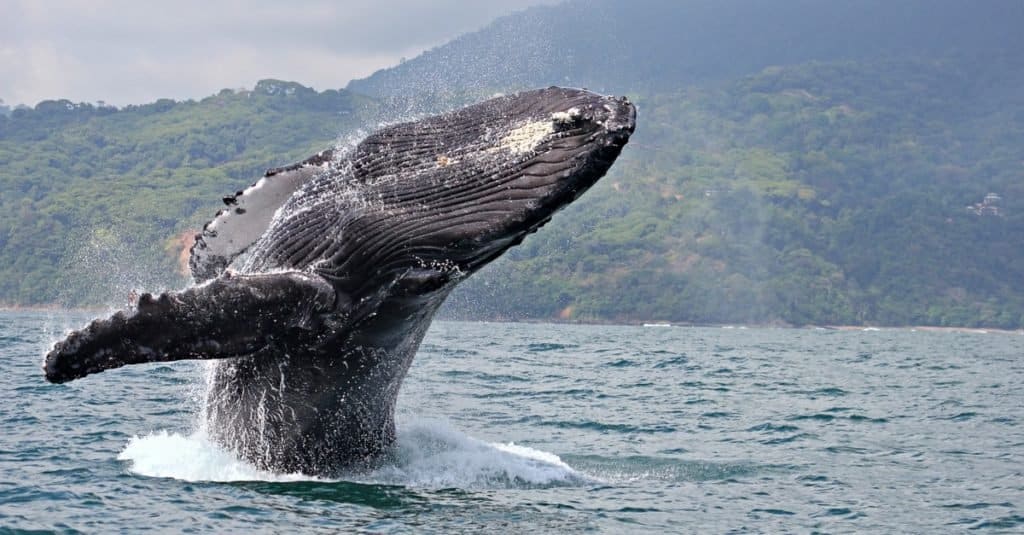If you’re like most people, you’ve at least seen photos or videos of whales leaping from the water. The grace and beauty they possess are unbelievable.
Whales and dolphins are the most likely animals that come to mind when we say “breaching,” but there’s more to the story! Not only are they just a few of the animals that leap gracefully from the water, but they also do it for more than fun or play.
What is Breaching?
Scientifically speaking, we define breaching as “an animal leaping from the water with at least 40% of its body out of the water.” However, you probably won’t be getting out measuring tapes to check — in most cases, it’s an estimate.
The strength needed for an animal to breach is relative to their size, which is why a great white shark or humpback whale breaching is so impressive. These massive creatures generate a tremendous amount of force in order to leave the water. With some animals, it’s enough to capsize a boat. This fact is why the whale-watchers try to maintain a safe distance.
Breaching or Porpoising?
On the other hand, porpoising is what most aquatic animals do most of the time. It’s where they swim at high speeds and leap from the water, skimming the surface. Dolphins and porpoises do this a lot in the bow wake of a ship. That’s not to say that animals other than whales don’t breach — they do. They’re just not as likely to do so.

“Breaching” is different than “porpoising.” “Porpoising” implies swimming at high speeds and leaping from the water, skimming the surface, just like this dusky dolphin is doing.
©Protected Resouces Division, Southwest Fisheries Science Center, La Jolla, California – Public Domain
Why Animals Breach
Depending on the species and circumstances, why an animal is leaping out of the water changes. Sometimes, it’s obvious —when a fish is fleeing a predator, for example. Other times, it’s not as obvious. Because they can’t tell us, no one really knows why most aquatic animals breach.
However, there are a few ideas.
Communication
Sound travels faster through the water than through the air. It’s why we can hear whale songs from miles and miles away from the whale doing the singing.
Because a whale makes a ton of noise when it splashes down after a leap, some scientists say that it’s possible whales (and some dolphins) use that to send some sort of message to others of its species.
Mating Display
Males have to work hard to get a female’s attention. Birds have brighter displays, but aquatic animals often take a different approach.
Some aquatic animals may use breaching as a way to show their strength and prowess to potential mates. Scientists say that male whales breach more often during mating season, which gives you the impression that perhaps they’re trying to show off to the females.
Removing Pests
Let’s face it, even animals that live in the water have to deal with parasites.
Lice is a problem for some whale species. So, it’s reasonable that a giant leap out of the water, followed by the splash at the end, might knock a few of them loose and give the gentle giant some relief.
Other aquatic animals have parasites that a giant splash-down may alleviate.
Escaping Predators & Chasing Prey
Possibly the most obvious reason for breaching is some animals leaping from the water in an attempt to avoid being eaten.
Ironically, their predator may follow them right on out of the water. Many people have video footage of seals fleeing great white sharks or orcas off the coast of South Africa. The seals try to escape by jumping several feet out of the water, often with the predator hot on their fins.
Moving From One Body of Water to Another
Salmon do this when they migrate to the location where they hatched. They’re famous for swimming upstream and leaping dramatically out of the water. However, they also breach in order to move from one body of water to another. For example, if there’s a small waterfall in the way between two sections of a river, the fish have to jump.
Just for Fun
Some animals, especially marine mammals like dolphins, whales, and porpoises, seem to leap from the water just for fun. They’re highly intelligent and play is a normal part of their day.

The strength needed for an animal to breach is relative to their size, which is why seeing a Humpback whale breaching is so impressive!
©Claude Huot/Shutterstock.com
Which Animals Breach
Most of the time, you probably think about a whale breaching. However, they’re not the only animals who exhibit the behavior. By no means exhaustive, here’s a list of some of the animals that breach.
Fish & Sharks
- African butterflyfish
- Alligator gar
- Atlantic salmon
- Blue marlin
- Betta fish
- Bluefin tuna
- Comet goldfish
- Brown trout
- Brook trout
- Chinook salmon
- Coho salmon
- Dorado (mahi-mahi)
- Flying fish
- Great white sharks
- Killifish
- Large-mouth bass
- Marbled hatchet fish
- Mullet fish
- Muskellunge
- Northern pike
- Peacock bass
- Rainbow trout
- Rainbowfish
- Red drum
- Stingrays
Whales & Dolphins
- Humpback whales
- Blue whales
- Spinner dolphins
- Bottlenose dolphins
- Orcas
- Porpoises



